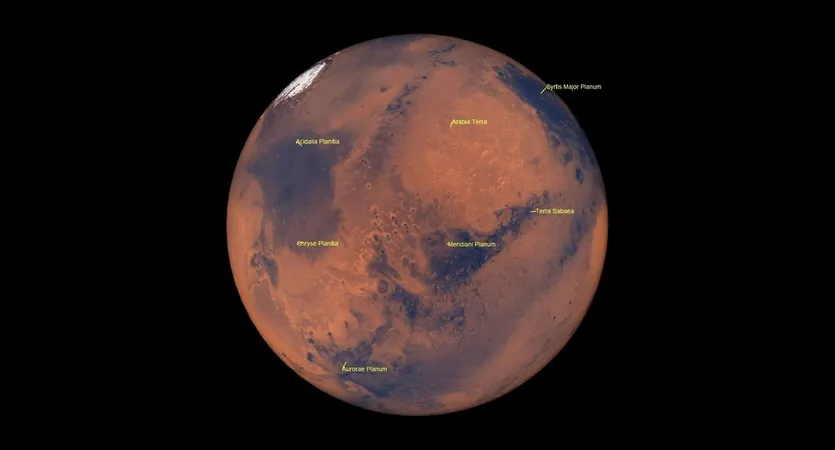
Mars Shines Brightest This Weekend – Don’t Miss Your Chance to See the Red Planet!
2025-01-10
Author: Sarah
This weekend, stargazers are in for a treat as Mars reaches its closest proximity to Earth, making it appear larger and more brilliant than it will all year. The Red Planet's close approach, known as perigee, occurs on Sunday, January 12, at 8:32 a.m. EST (13:32 GMT), providing an exceptional opportunity for skywatching.
From New York City, Mars will be visible starting around 5:43 p.m. EST (22:43 GMT), when it ascends to a height of 7 degrees above the northeastern horizon. The highlight of the evening will occur when Mars reaches its peak at 74 degrees above the southern horizon at 12:29 a.m. EST on January 13. It will remain in sight until roughly 6:58 a.m. EST the next morning, when it dips to 14 degrees above the northwest horizon and fades into the dawn light.
During this approach, Mars will align within 0.64 astronomical units (AU) from Earth—where one AU represents the average distance to the sun, approximately 93 million miles (150 million kilometers). For context, Mars typically orbits the sun at an average distance of 1.5 AU, and at its most distant (apogee) can be around 2.6 AU away from us.
This perigee marks the closest Mars has been to our planet since 2022, when it reached 0.54 AU. Adding to the excitement, Mars will also be at opposition on January 16, when it sits almost directly opposite the sun in the sky, allowing for optimal viewing conditions. Typically, these two significant events—perigee and opposition—happen just days apart due to the orbits of Earth and Mars.
When Mars is at its brightest—boasting a maximum magnitude of -1.4—observers can expect a spectacular display. However, it's important to note that despite appearing larger and brighter, Mars will still look like a star-like point of light to the naked eye. To catch a glimpse of its features and surface details, you'll need binoculars or a telescope.
For those eager to enhance their skywatching experience, now is a great time to invest in binoculars or a telescope. With many options available, you can find the perfect tool to help unveil the beauty of Mars and other celestial bodies. Don't forget to brush up on tips for capturing stunning photographs of planets, making this celestial event one you won't want to miss!
Mark your calendars and get ready to experience one of the most breathtaking astronomical events of the year!





 Brasil (PT)
Brasil (PT)
 Canada (EN)
Canada (EN)
 Chile (ES)
Chile (ES)
 Česko (CS)
Česko (CS)
 대한민국 (KO)
대한민국 (KO)
 España (ES)
España (ES)
 France (FR)
France (FR)
 Hong Kong (EN)
Hong Kong (EN)
 Italia (IT)
Italia (IT)
 日本 (JA)
日本 (JA)
 Magyarország (HU)
Magyarország (HU)
 Norge (NO)
Norge (NO)
 Polska (PL)
Polska (PL)
 Schweiz (DE)
Schweiz (DE)
 Singapore (EN)
Singapore (EN)
 Sverige (SV)
Sverige (SV)
 Suomi (FI)
Suomi (FI)
 Türkiye (TR)
Türkiye (TR)
 الإمارات العربية المتحدة (AR)
الإمارات العربية المتحدة (AR)